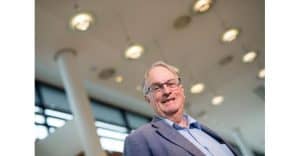Fifty years later, the tale of his battery’s birth sounds improbable. Whittingham was young, fresh off a postdoc program at Stanford University, and working for the Exxon Corp. in New Jersey. Ironically, his battery concept would not benefit Exxon. Its early applications would include camcorders, laptop computers, and cell phones, none of which had any remote linkage to Exxon. Later, his concept would end up powering electric cars around the world, serving as a direct competitor to Exxon’s oil. In retrospect, it seems impossible that Exxon could have supported such research. But it did.
Intercalation Chemistry
Whittingham’s work at Exxon moved rapidly. He joined the company in September of 1972, and within a few weeks began working on a concept he had studied at Stanford. The concept involved inserting ions into the atomic lattice of certain metals, and then extracting those ions. It was called intercalation (pronounced “in-TURK-a-lay-shun”). “I said, ‘Hey, we can store energy here,” he recalled in the book, Long Hard Road: The Lithium-Ion Battery and the Electric Car. “And that’s when we got into electrochemical studies, and then batteries.”
He decided to build a battery using intercalation materials at both electrodes. First, he considered a variety of layered compounds and chose titanium for the battery’s cathode. Then came the decision that changed the history of science. For an anode, he initially examined potassium, but decided it was too hazardous. He soon settled on a soft, silvery, lightweight metal…lithium. Ultimately, he would use lithium in the battery’s anode, then in its electrolyte. The results were astonishing. Whereas the best batteries of the day operated at 1.3 volts, this new battery offered 2.4 volts. And, thanks to the science of intercalation, it was rechargeable. Working versions of Whittingham’s lithium titanium disulfide battery were finished by December 1972.
A month later, Whittingham was summoned by Exxon corporate managers to their New York City offices. “I was asked to talk to a subcommittee of the Exxon board and explain what I was doing,” Whittingham recalled. “Someone in research had told them what was going on,” he said in Long Hard Road. “ So I went in there and explained it—five minutes, ten at the most. And within a week they decided, yes, they wanted to invest in this.”
That Exxon should have invested in a technology that would compete with oil now seems incredible. But the world was different in 1972. Scientific consensus at the time held that the Earth would run out of oil in 50 years. By 2000, scientists said, oil availability would be on a serious slide. Moreover, the culture of corporate research was different in 1972. Big companies, Exxon being a case in point, deeply believed in the concept of fundamental research—science for the sake of science. Scientific papers and patents were the goal. If a breakthrough were to be made, it was assumed the company would figure out how to benefit from it.
Such was the case for Whittingham. He was encouraged to move ahead. He did so, and Exxon filed for a patent in Belgium in 1973. When an oil crisis struck in the United States in 1973, Exxon’s sense of urgency grew. By 1975, its attorneys were filing for a flurry of U.S. patents on Whittingham’s battery.
To be sure, Whittingham’s battery was not called lithium-ion, nor did it use the same chemistry as today’s products. But it operated off the same fundamental mechanism—lithium ions inserted into a host electrode. A tiny button cell version of the battery was fabricated and employed in a “perpetual solar wristwatch” sold by a Swiss company, Ebauches SA. There, it served perfectly. What’s more, it was almost impossible to look at this new battery and not think about a potential future in an electric car.
Still, Exxon slowly lost interest in the lithium titanium disulfide battery. The oil crisis faded, the wristwatch application was deemed insignificant, and corporate priorities changed. Ultimately, the company’s managers decided to sell off the technology. The battery was licensed to three companies—one in Asia, one in Europe, and one in the U.S. “There wasn’t a lot of discussion,” Whittingham said years later. “One day they just said, ‘We’re going to stop doing this.’”
Saved by the Camcorder
But the rechargeable lithium battery was not dead. In 1980, John Goodenough, a 58-year-old American working at the University of Oxford in England, improved on Whittingham’s battery with a new cathode. Goodenough’s cathode was called lithium cobalt oxide, and it offered an amazing four volts. Now the battery was even better—more energetic and yet still rechargeable. There was nothing like it on the commercial market.

